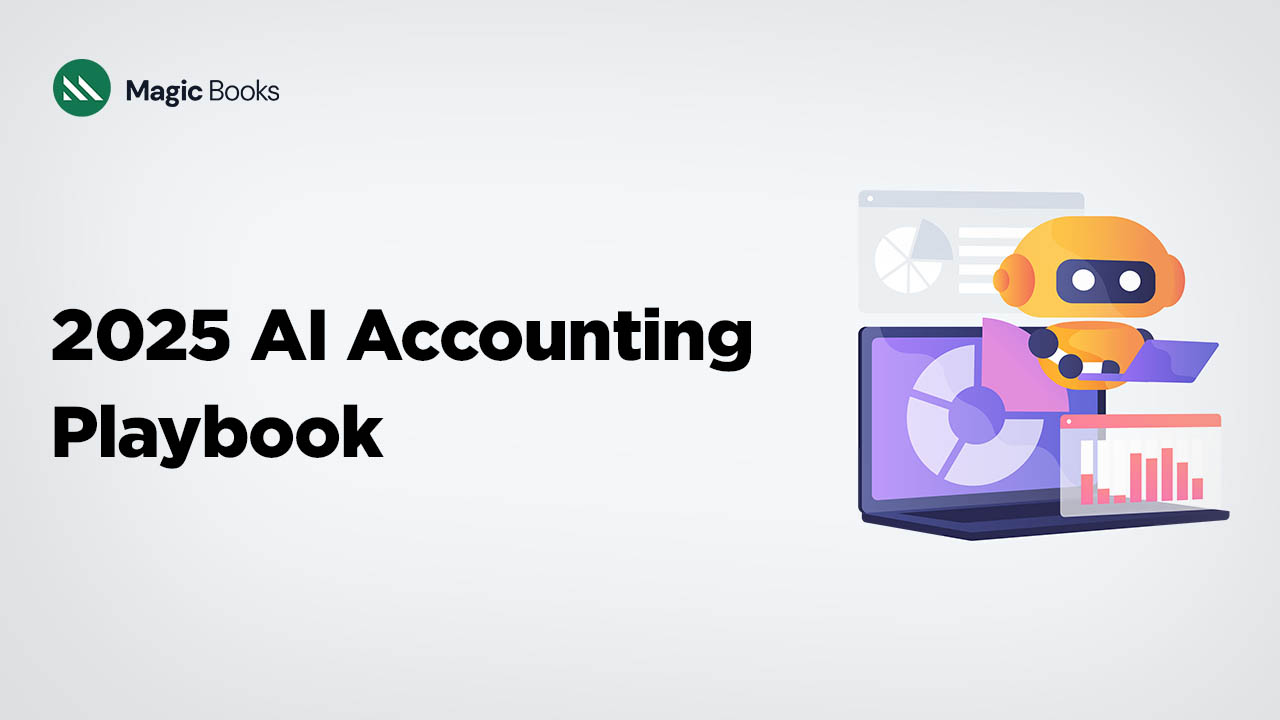While Accounting has historically served as the pillar for every organization, in 2025 it is the proving ground for AI’s potential. As Link My Books states: in 2022, 38% of accounting firms were utilizing AI in their core activities, today it is 61%. More critically, AI has decreased a firm’s time on each process by an average of 20%.
Simultaneously, approximately half of technology leaders are reporting that their finance strategy is using AI, an increase from 30% in 2024.
These statistics reinforce why 2025 is a tipping point; the technology has matured and is now ready for unique applications, data infrastructures are consolidating; and regulators are clarifying guidance around the governance of AI.
In this, we examine the three key takeaways each senior finance leader should know:
- Hyper-Automation of Repetitive Processes
- Real-Time Insights & Prediction
- Risk Management & Compliance at Speed
Each section integrates both quantitative data, practical examples from the real world, and recommendations for evaluating AI-based solutions and preparing your teams for the next phase of financial transformation.
Hyper-Automation of Repetitive Tasks:
Hyper-automation unifies RPA, AI bots, and machine-learning models to automate manual accounting, reconciliation, and expense processes. The top firms, including Deloitte, have launched in-house AI chatbots; Deloitte’s “PairD” is now used monthly by 75% of UK audit professionals, up from 25% a year ago, producing over 1.1 million prompts from April 2024 through February 2025. EY’s generative-AI-based fraud detection technology has minimized audit times by up to 25% in some most and secured cost savings of 20–25% on pilot engagements as well.
Deloitte PairD Usage: 75% of auditors use it every month, compared to 25% — 1.1 million total prompts in 10 months.
Industry Examples & Case Studies
- As per Karbon’s State of AI in Accounting Report, the early adopters experience month-end closes that are 30% quicker and realize a 20% reduction in reconciliation errors.
- Mordor Intelligence predicts the AI in Accounting market to expand at a 41.3% CAGR to $37.6 billion by 2030.
- Grant Thornton’s AI@GT initiative automated 40% of mundane work, increasing staff satisfaction and reserving teams for advisory work.
Estimated ROI & Productivity Return:
Mid-sized companies embracing hyper-automation can expect a payback of 9–12 months with an average ROI of 150–200% in three years. Large enterprise companies have realized a 2–3 fold boost in productivity on GAAP accounting operations and a 30% decrease in FTE headcount focused on transaction work.
Critical drivers are:
- Cost savings in labor through robot-operated transaction processing
- Elimination of errors through AI-powered anomaly detection
- Scalability—bots handle seasonal workloads without new hires
Real-Time Intelligence and Predictive Analytics:
AI Dashboards Turn Data into Decisions:
AI-powered dashboards have now replaced static spreadsheets with real-time transactional data, executing sophisticated analysis, and providing pointed insights in real time. According to ThoughtSpot, such organizations have decreased the time to develop actionable intelligence by about 25%, thus enabling leaders to recognize and react to changes in cash flow more rapidly than ever before.
For example, a mid-market retailer integrated J.P. Morgan’s AI-powered cash-flow forecasting system into its ERP system. When it picked up on an unplanned 15 percent drop in receivables, the Chief Financial Officer of the company could redirect $5 million from short-term buffers in real time. This averted what might have been a liquidity crisis and prevented approximately $2 million in the cost of potential credit-line borrowing.
Smooth integration with AI systems and leading ERPs such as SAP and Oracle enable predictive models to learn from each and every new transaction. CFOs are no longer scorekeepers of yesteryears but strategic business partners empowered by AI-driven scenario planning. The CFO of the future will be focused on developing data literacy among finance teams, using AI in rolling forecasts and dynamic budgeting, and working closely with IT to develop robust governance and ethical standards around AI adoption.
How accountants or finance teams use these tools:
Accountants and finance experts now utilize AI-driven platforms to draw in and reconcile ERPs, bank feeds, and payment systems’ data in real time, cutting out manual imports and providing a single source of truth for all financial activity. These systems automatically sort general ledger postings into categories, assign the correct tax codes, and flag duplicates or discrepancies, minimizing human mistakes and speeding month‐end close by as much as 60%. Live dashboards present key performance indicators—cash flow, receivables aging, payables due, and budget variances—and even allow natural‐language queries such as “What’s our free cash flow this month?” for instant narrative color. By feeding machine learning into historical and real-time data, AI constructs rolling forecasts that dynamically change as new transactions post, while scenario-planning models allow teams to compare the effect of an unexpected sales decline or cost surge in minutes, not days. Real-time anomaly detection notifies professionals of odd patterns, such as possible fraud or billing errors, so that they can investigate immediately before small issues turn into big problems. Free from time-consuming tasks such as invoice coding and bank reconciliation, accountants can concentrate on strategic analysis, counseling leadership on investment decisions, risk avoidance, and long-term financial planning—all fueled by reliable, AI-driven insights.
Risk Management and Compliance at Scale:
AI-Based Anomaly Detection & Fraud Prevention:
AI algorithms trained from historical ledgers can now recognize outliers in just seconds—sensing fraudulent orders, duplicate invoices, and inside-trading indications before they trigger. EY’s fraud identification pilot identified irregularities that are overlooked by typical sampling techniques and lowered false negatives by 40%.
Changing U.S. Regulatory Guidelines:
Regulators are moving from a “move fast, break things” model to requiring effective AI governance:
- SEC AI Roundtable (March 27, 2025): The SEC had an open discussion on the issue of AI risk, governance, and investor disclosure.
- PCAOB Spotlight on AI (July 2024): PCAOB issued comments on applying generative AI in audits with a focus on transparency and documentation.
- The new SEC 10-K rules require companies to clearly outline the material effects of AI on their business and related risk factors. These advances require compliance teams to work very closely with technology functions in order to integrate controls into AI processes.
Effect on Accountants:
Accountants are now being asked to broaden the scope of conventional audit documentation to include AI model inputs, outputs, and decision rules in order to achieve a complete audit trail for any AI-based adjustments or projections. They need to validate the data ingested by AI systems, making it complete, accurate, and pertinent to the SEC’s materiality criteria and avoiding “AI washing” in annual reports. Continuous transaction monitoring through AI necessitates accountants to interpret algorithmic flags and validate anomalous patterns with source documents, thereby turning periodic audit procedures into near-real-time audits. Accountants need to keep pace with the strengths and weaknesses of AI, working in conjunction with clients’ IT to understand model training data and governance policies, so that financial analyses based on AI are defensible and transparent.
Effect on Compliance Officers:
Compliance officers must incorporate AI governance into overall risk and control processes now, aligning AI processes with internal control goals (e.g., COSO) and regulatory requirements. They must put in place AI model monitoring policies—defining ownership, change-management procedures, and escalation procedures—such that AI-driven processes are PCAOB documentation compliant and SEC disclosure compliant. In close collaboration with legal and technology teams, compliance leaders will develop AI risk-assessment templates to evaluate new AI implementations for data privacy, security, and ethical implications before approving them for production. Finally, compliance officers must update training programs to increase AI literacy among finance staff and to ensure AI disclosures in the 10-K are accurate, relevant, and not boilerplate.
AI Governance Best Practices:
1. Set up a Specific AI Governance Committee:
Set up a cross-functional team consisting of finance, risk, legal, IT, and internal audit to oversee AI initiatives and hold individuals responsible. This committee sets risk appetites, sanctions policies, and reviews escalations.
2. Implement an Established Risk Management System:
Apply the NIST AI Risk Management Framework (AI RMF) to discover, evaluate, and control artificial intelligence risks in your organization. The GOVERN function of the framework sets policies, procedures, and practices required to provide good governance. Alternatively, apply AI-related COBIT extensions for IT governance and value creation goals alignment.
3. Implement Clear Policies and Procedures:
Produce guidelines for data gathering, model development, testing, deployment, and retirement. Incorporate policies to feature data minimization, access controls, versioning, and incident response to model failure.
4. Use Model Documentation and “Model Cards”:
For each AI system, keep a model card that records purpose, training data characteristics, performance metrics, known limitations, and bias-testing results. Transparency makes audits and stakeholder understanding easier.
5. Carry Out Routine Bias and Fairness Audits:
Organize regular reviews of AI outputs to identify and counteract biased or discriminatory behavior. Measure trustworthiness traits—like fairness, explainability, and resilience—against ISACA standards.
6. Use an Artificial Intelligence Audit Toolkit:
Utilize a control library, such as ISACA’s AI Audit Toolkit, to verify that systems meet governance standards and ethical standards. This procedure allows the internal auditors to perform a structured compliance review.
7. Offer Continuous Training and Culture-Building:
Integrate artificial intelligence ethics and governance into employee training and thus reinforce policy and an ethical culture of AI use.
Next Steps for Financial Leaders:
1. Joint Assessment for AI Readiness:
Start by engaging your selected AI vendor to perform a co-branded self-audit of Strategy, Data, Technology, People, Processes, Governance, and Ethics. Have them use their diagnostic tool to determine which tax-reporting functions, audit-verification processes, or bookkeeping entries hold the greatest promise for efficiency gains. The joint audit produces a roadmap with combined milestones, success measures, and deployment schedules.
2. Strategic Investment in Collaborative Creation:
Instead of purchasing off-the-shelf modules, spend about 70% of your AI budget on collective organizational change—co-training on tax-logic automation and AI ethics, process redesign workshops, and reward programs for pioneer teams. Spend 20% on developing secure data pipelines with the vendor and 10% on collectively optimizing the underlying algorithms behind audit-prep checklists and bookkeeping categorization.
3. Cross-Functional Co-Innovation Teams:
Assemble joint teams of your tax experts, internal auditors, and bookkeeping leaders with the vendor’s data scientists, solution architects, and compliance specialists. These teams will co-create and iterate proof-of-concept pilots, such as a next-generation tax-return builder or artificial intelligence aide that pre-populates audit schedules, thus enabling you to prove value and achieve scale quickly.
4. Co-Developed Vendor Partnership Model:
Create a partnership charter that focuses on open-API architectures to prevent lock-in, common governance processes for audit trails and bias testing, and vendors’ commitments to deliver documentation to SEC/PCAOB standards. Pilot at low scale with well-specified “go/no-go” criteria to ensure that successful modules can be rolled out firm-wide with minimal rework.
5. Continuous Improvement and Cooperation:
Government Form a joint AI Governance Committee with your compliance department and vendor representatives to review automated monitoring dashboards for model drift, performance degradation, and ethics concerns on a quarterly basis. Leverage industry consortia and vendor-hosted best-practice forums to stay ahead of regulatory change and mature your co-developed tax, audit, and bookkeeping solutions over the long term.
AI is no longer a “nice-to-have” in accounting, it is transforming the profession from transaction processing to strategic stewardship. Hyper-automation is reducing close times and errors. Real-time predictive analytics are moving CFOs up the ladder not to managerial roles, but into leaders of foresight. Predictive analytics evolve risk framework for organizations as compliance is adapting to SEC and PCAOB changes in rules.



